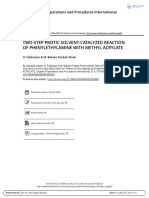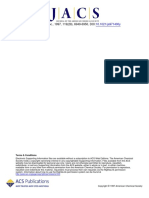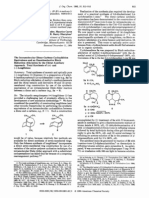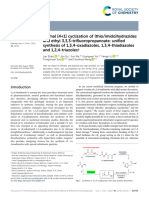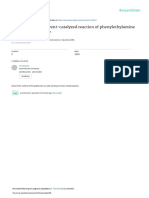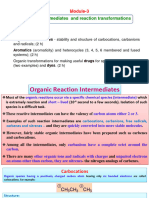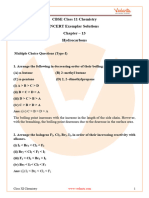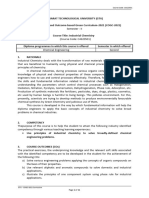Enantioselective Intermolecular (2 + 2) - Photocycloaddition Reactions of Alkenes and A 2-Quinolone in Solution
Enantioselective Intermolecular (2 + 2) - Photocycloaddition Reactions of Alkenes and A 2-Quinolone in Solution
Uploaded by
M PadilCopyright:
Available Formats
Enantioselective Intermolecular (2 + 2) - Photocycloaddition Reactions of Alkenes and A 2-Quinolone in Solution
Enantioselective Intermolecular (2 + 2) - Photocycloaddition Reactions of Alkenes and A 2-Quinolone in Solution
Uploaded by
M PadilOriginal Title
Copyright
Available Formats
Share this document
Did you find this document useful?
Is this content inappropriate?
Copyright:
Available Formats
Enantioselective Intermolecular (2 + 2) - Photocycloaddition Reactions of Alkenes and A 2-Quinolone in Solution
Enantioselective Intermolecular (2 + 2) - Photocycloaddition Reactions of Alkenes and A 2-Quinolone in Solution
Uploaded by
M PadilCopyright:
Available Formats
J. Am. Chem. Soc.
2000, 122, 11525-11526 11525
Enantioselective Intermolecular Scheme 1
[2 + 2]-Photocycloaddition Reactions of Alkenes and
a 2-Quinolone in Solution
Thorsten Bach*,† and Hermann Bergmann‡
Lehrstuhl für Organische Chemie I
Technische UniVersität München
D-85747 Garching, Germany
Fachbereich Chemie,
Philipps-UniVersität Marburg
D-35032 Marburg, Germany
ReceiVed July 20, 2000
ReVised Manuscript ReceiVed September 26, 2000
In recent years, there has been tremendous progress in the
enantioselective synthesis of strained compounds by intramo-
lecular photochemical reactions.1 Chiral organic2 and inorganic3 Scheme 2
complexing agents have been employed successfully in solid-
state photochemistry. Homochiral crystals of prochiral substrates
have been obtained by the “ionic chiral auxiliary” approach4 or
by other methods5 and yielded enantiomerically enriched products
upon irradiation. In the liquid phase, many efforts have centered
on the use of circular polarized light to induce an effective
differentiation of enantiotopic faces and enantiomeric excesses
(ee’s) up to 64% have been recorded.6 Enantioselective photo-
cycloaddition reactions in solution have been achieved using chiral
host molecules which bind the substrate by hydrogen bonding.7
An advantage of the latter approach as compared to the methods based receptors which we have recently prepared in our labora-
employed in the solid state is the fact that it should also be tory.7,12 The endo- and exo-isomers 2 and 3 and their enantiomers
applicable to intermolecular photochemical reactions of two ent-2 and ent-3 are obtained as products, the exo/endo ratio being
different reaction partners. Contrary to the classical auxiliary- dependent on the substituent R (vide infra).
based methodology which has been elegantly applied in photo- Binding to a chiral host should facilitate a differentiation of
cycloaddition chemistry8,9 the use of a noncovalently bound the enantiotopic faces of compound 1. For the current set of
complexing agent avoids the cleavage of the chiral source.10 We experiments we have employed the chiral amide 4 and its
would now like to report on our preliminary results with regard enantiomer ent-4 (Scheme 2). As depicted in Scheme 2 the
to enantioselective (81-98% ee) intermolecular [2 + 2]-photo- quinolone 1 was expected to coordinate to the lactam 4 with its
cycloadditions in solution. NH-group being the hydrogen donor and with the carbonyl group
The quinolone 1 is known to undergo a [2 + 2]-photocyclo- being the hydrogen acceptor. In previous studies it was shown
addition with different alkene substrates (Scheme 1).11 Its lactam that the association contants of six-membered lactams related to
functionality should be well suited for binding to the lactam- 1 and host molecules related to 4 are high and that the
†
Technische Universität München. self-association of the host is low.13 It was consequently expected
‡
Philipps-Universität Marburg. that the quinolone 1 undergoes a selective photocycloaddition,
(1) Reviews: (a) Everitt, S. R. L.; Inoue, Y. In Molecular and Supramo- provided that it binds to the host and provided that the
lecular Photochemistry: Organic Molecular Photochemistry; Ramamurthy,
V., Schanze, K. S., Eds.; Dekker: New York, 1999; Vol. 3, p 71. (b) Inoue, intermolecular reaction occurs at the bound substrate.
Y. Chem. ReV. 1992, 92, 741. (c) Rau, H. Chem. ReV. 1983, 83, 535. The studies were conducted with different alkenes (Scheme 1,
(2) Reviews: (a) Ito, Y. Synthesis 1998, 1. (b) Toda, F. Acc. Chem. Res. Table 1). Only selected experimental data are provided in Table
1995, 28, 480.
(3) Review: Joy, A.; Ramamurthy, V. Chem. Eur. J. 2000, 6, 1287-1293. 1, additional data can be found in the Supporting Information.
(4) Review: Gamlin, J. N.; Jones, R.; Leibovitch, M.; Patrick, B.; Scheffer, The best results were obtained at low-temperature employing an
J. R.; Trotter, J. Acc. Chem. Res. 1996, 29, 203. excess of the host (entries 1, 2, and 3). Either enantiomer of the
(5) Review: Sakamoto, M. Chem. Eur. J. 1997, 3, 684.
(6) Inoue, Y.; Wada, T.; Asaoka, S.; Sato, H.; Pete, J.-P. J. Chem. Soc., host 4 or ent-4 was used in these experiments. As expected the
Chem. Commun. 2000, 251 and references therein. product with opposite configuration was obtained upon exchang-
(7) Bach, T.; Bergmann, H.; Harms, K. Angew. Chem., Int. Ed. 2000, 39, ing the host (entries 4 and 5). In the case of vinyl acetate (R )
2302.
(8) For seminal contributions, see: (a) Tolbert, L. M.; Ali, M. B. J. Am. OAc) both cyclobutane isomers ent-2c (endo) and ent-3c (exo)
Chem. Soc. 1982, 104, 1742. (b) Koch, H.; Runsink, J.; Scharf, H.-D. were isolated. The optical purity of the two diastereoisomers was
Tetrahedron Lett. 1983, 24, 3217. (c) Meyers, A. I.; Fleming, S. A. J. Am. similar (entry 6). In general, the simple diastereoselectivities
Chem. Soc. 1986, 108, 306. (d) Demuth, M.; Palomer, A.; Sluma, H.-D.; Dey,
A. K.; Krüger, C.; Tsay, Y.-H. Angew. Chem. 1986, 98, 1093; Angew. Chem., (endo/exo ratios) determined in the presence of the chiral host
Int. Ed. Engl. 1986, 25, 1117. did not significantly differ from the diastereoselectivities obtained
(9) Reviews: (a) Fleming, S. A.; Bradford, C. L.; Gao, J. J. In Molecular
and Supramolecular Photochemistry: Organic Photochemistry; Ramamurthy, (11) (a) Kaneko, C.; Naito, T.; Chem. Pharm. Bull. 1979, 27, 2254. (b)
V., Schanze, K. S., Eds.; Dekker: New York, 1997; Vol. 1, p 187. (b) Bach, Kaneko, C.; Naito, T. Heterocycles 1982, 19, 2183. (c) Kaneko, C.; Suzuki,
T. Synthesis 1998, 683. (c) Mattay, J.; Conrads, R.; Hoffmann, R. In Methoden T.; Sato, M.; Naito, T. Chem. Pharm. Bull. 1987, 35, 112-123.
der Organischen Chemie (Houben-Weyl), 4th ed.; Helmchen, G., Hoffmann, (12) For the synthesis of related compounds and their use as chiral
R. W., Mulzer, J., Schaumann, E., Eds.; Thieme: Stuttgart, 1995; Vol. E 21c, auxiliaries, see: Stack, J. G.; Curran, D. P.; Geib, S. V.; Rebek, Jr., J.; Ballester,
p 3085. P. J. Am. Chem. Soc. 1992, 114, 7007.
(10) For the use of chiral proton sources in enantioselective photodecon- (13) Bach, T.; Bergmann, H.; Harms, K. J. Am. Chem. Soc. 1999, 121,
jugation reactions, see: Pete, J.-P. AdV. Photochem. 1996, 21, 135. 10650.
10.1021/ja0026760 CCC: $19.00 © 2000 American Chemical Society
Published on Web 11/03/2000
11526 J. Am. Chem. Soc., Vol. 122, No. 46, 2000 Communications to the Editor
Table 1. Enantioselective Photocycloaddition of the 2-Quinolone 1 in the Presence of the Chiral Host Compounds 4 and ent-4
entry Ra temp [°C] time [h]b host equiv drc (3/2) yield [%]d product ee [%]e
1 CH2CH2CH2OH 30 2 4 1.4 >95/5 75 3a 30
2 CH2CH2CH2OH -20 10 4 1.3 >95/5 74 3a 52
3 CH2CH2CH2OH -60 10 4 2.4 >95/5 80 3a 81
4 CH2OAc -60 10 4 2.4 >95/5 80 3b 92
5 CH2OAc -60 10 ent-4 2.4 >95/5 81 ent-3b 91
6 OAc -60 10 ent-4 2.4 63/27 89 ent-3c 93
ent-2c 98
7 Ph -60 10 4 2.4 <5/95 10 f 2d 83
8 COOCH3 -60 10 4 2.4 90/10 84 3e 82 g
a The reaction was conducted in an immersion apparatus (Duran filter; light source: Original Hanau TQ 150). The quinolone concentration was
2 × 10-3 M in toluene as the solvent. The alkene was used in excess (20 equiv). After complete conversion the solvent and the excess alkene was
removed in vacuo and the residue was purified by flash chromatography (gradient: tert-butyl methyl ether/pentane). b Time after which the conversion
was complete (except for entry 7). c The diastereomeric ratio of cyclobutanes in the crude product was determined by integration of appropriate 1H
NMR signals. d Yield of isolated product. e The enantiomeric excess was determined by chiral HPLC (Chiracel OD; eluent: hexane/i-propanol )
92/8). f The reaction remained incomplete even upon prolongued irradiation. 65% of the quinolone was recovered. g The enantiomeric excess was
determined by chiral HPLC after reduction (LiBH4 in THF/EtOH) to the corresponding amino alcohol.
in its absence (see Supporting Information). The enantiomeric Scheme 3
excesses achieved at -60 °C were high, and they demonstrate
that the enantioface differentiation provided by the bulky tetra-
hydronaphthalene backbone is very efficient. The host was
recovered after separation by flash chromatography (80-95%
recovery).
The assignment of the absolute configuration was based on
our previous results obtained in the intramolecular reaction of
2-quinolones.7 A Re face attack at the carbon atom C-3 occurs if
host 4 is employed. As depicted in Scheme 2, Re attack at this
Acknowledgment. This paper is dedicated to Professor Horst Kunz
position leads to the formation of products 2 (endo) or 3 (exo).
on the occasion of his 60th birthday. This work was generously supported
The relative configuration was assigned based on NOESY data by the Deutsche Forschungsgemeinschaft and by the Fonds der Chemis-
and on previous work.11 The enantioselective photochemical chen Industrie.
reaction was extended to symmetrical 1,1-disubstituted alkenes.
As an example the conversion of 2-ethyl-1-butene (5) to the
cyclobutane 6 is presented in Scheme 3. Supporting Information Available: Comprehensive table of the
In summary, the host compound 4 and its enantiomer ent-4 irradiation study including the irradiation results in the absence of the
host; NMR data and spectra (1H, 13C) of 2c, 2d, 3a, 3b, 3c, 3e, and 6;
have proved to be reliable chiral complexing agents for enantio-
further analytical data and HPLC analyses of 3a, 3b (entry 4), 2c and 3c
selective intermolecular [2 + 2]-photocycloaddition reactions of
(entry 6), 2d (entry 7), and 6 (Scheme 3) (PDF). This material is available
2-quinolones. Further studies are directed toward additional free of charge via the Internet at http://pubs.acs.org.
applications of these hosts in inter- and intramolecular photo-
chemical reactions. These results will be reported in due course. JA0026760
You might also like
- A Rapid, High-Yield Conversion of Codeine To MorphineDocument2 pagesA Rapid, High-Yield Conversion of Codeine To Morphinegeovani250% (2)
- Book ListDocument491 pagesBook Listphantanthanh0% (1)
- Leuckart ReactionDocument3 pagesLeuckart ReactionKybernetikum100% (1)
- Copper-Boxmi Complexes As Highly Enantioselective Catalysts ForDocument5 pagesCopper-Boxmi Complexes As Highly Enantioselective Catalysts Forxuyijing2007comNo ratings yet
- Efficient Synthesis of 3-Cyano-6 - (2-Hydroxyphenyl) Pyridines by Multi-Component Condensations On BeadsDocument3 pagesEfficient Synthesis of 3-Cyano-6 - (2-Hydroxyphenyl) Pyridines by Multi-Component Condensations On BeadsBandita DattaNo ratings yet
- The Effect of Ultrasound On The Yields of Heck ReaDocument7 pagesThe Effect of Ultrasound On The Yields of Heck ReaRahaf AljboriNo ratings yet
- Harzialactone TA 2005 LuDocument3 pagesHarzialactone TA 2005 LuhloicNo ratings yet
- Two-Step Protic Solvent-Catalyzed Reaction of Phenylethylamine With Methyl Acrylate (Organic Preparations and Procedures International, 2005, 37, 6, 579-584 10.1080@00304940509354990)Document7 pagesTwo-Step Protic Solvent-Catalyzed Reaction of Phenylethylamine With Methyl Acrylate (Organic Preparations and Procedures International, 2005, 37, 6, 579-584 10.1080@00304940509354990)DmitryNo ratings yet
- GM - Synth Commun - Aza - 2008Document8 pagesGM - Synth Commun - Aza - 2008Rudraksha BhattacharyaNo ratings yet
- Sintesis de Azirina CON TOLUENO Y REDUCCION DE AZIDADocument11 pagesSintesis de Azirina CON TOLUENO Y REDUCCION DE AZIDAJuan Javier M. VegaNo ratings yet
- Dyes and Pigments-2016-New Class of Hyperpolarizable Push-Pull Organic Chromophores by Applying A Novel and Convenient Synthetic StrategyDocument5 pagesDyes and Pigments-2016-New Class of Hyperpolarizable Push-Pull Organic Chromophores by Applying A Novel and Convenient Synthetic StrategyELKIN ALFONSO RODRIGUEZ AGUALIMPIANo ratings yet
- Control of Reactivity of Novolac Resins: The Use of 3,4-Dihydro-2h-Pyran As A Labile Protecting GroupDocument7 pagesControl of Reactivity of Novolac Resins: The Use of 3,4-Dihydro-2h-Pyran As A Labile Protecting GroupQuế NghiNo ratings yet
- Total Synthesis of Samaderine Y From S CarvoneDocument4 pagesTotal Synthesis of Samaderine Y From S CarvoneĐỗ Nam ThànhNo ratings yet
- Hamdy 2013Document4 pagesHamdy 2013Redouane idrissiNo ratings yet
- MS 204Document4 pagesMS 204Suyog patilNo ratings yet
- Umihara Et Al-2017-Chemistry - A European JournalDocument3 pagesUmihara Et Al-2017-Chemistry - A European JournalNathalia MojicaNo ratings yet
- Total Synthesis of Mycophenolic Acid: Am. ChemDocument5 pagesTotal Synthesis of Mycophenolic Acid: Am. Chemapi-19973331No ratings yet
- A Rapid High Yield Conversion of Codeine To MorphineDocument7 pagesA Rapid High Yield Conversion of Codeine To Morphinemehdighorbani2002No ratings yet
- A General Synthesis of Mono and DisubstiDocument4 pagesA General Synthesis of Mono and DisubstijerardildefonsoNo ratings yet
- Synthesis MenthadienolDocument2 pagesSynthesis MenthadienolAnonymous Gb9EyW100% (1)
- PT (IV) - Catalyzed Hydroamination Triggered Cyclization: A Strategy To Fused Pyrrolo (1,2-A) Quinoxalines, Indolo (1,2-A) Quinoxalines, and Indolo (3,2 - C) QuinolinesDocument10 pagesPT (IV) - Catalyzed Hydroamination Triggered Cyclization: A Strategy To Fused Pyrrolo (1,2-A) Quinoxalines, Indolo (1,2-A) Quinoxalines, and Indolo (3,2 - C) QuinolinesDiogomussumNo ratings yet
- Total Synthesis of - Cyanthiwigin U: Matthew W. B. Pfeiffer and Andrew J. PhillipsDocument2 pagesTotal Synthesis of - Cyanthiwigin U: Matthew W. B. Pfeiffer and Andrew J. PhillipsPhạm Gia KhánhNo ratings yet
- Ja971400y Si 001Document14 pagesJa971400y Si 001mike van dorsselaerNo ratings yet
- Modification of The Hofmann Rearrangement, Synthesis of Methyl CarbamatesDocument3 pagesModification of The Hofmann Rearrangement, Synthesis of Methyl CarbamatesIsmet KutlukNo ratings yet
- Lewis Acid Induced Nubleophilic Substitution (Heck)Document4 pagesLewis Acid Induced Nubleophilic Substitution (Heck)bemestaremacaohojeNo ratings yet
- Triphenylphosphine Dibromide A Simple One-Pot Esterification ReagentDocument16 pagesTriphenylphosphine Dibromide A Simple One-Pot Esterification ReagentRasha El-GhazawyNo ratings yet
- Aromatic C-SDocument4 pagesAromatic C-SBhuvnesh singhNo ratings yet
- The Preparation of Furoin-A Biomimetic Reaction: 1. R' R' ' - C H C H O P O H )Document1 pageThe Preparation of Furoin-A Biomimetic Reaction: 1. R' R' ' - C H C H O P O H )Ingrid Gómez GarzónNo ratings yet
- 1a PublicacionDocument11 pages1a PublicacionRoly RcmNo ratings yet
- Synthesis and Regiochemistry of (60) Fullerenyl 2-Methylmalonate Bisadducts and Their Facile Electron-Accepting PropertiesDocument10 pagesSynthesis and Regiochemistry of (60) Fullerenyl 2-Methylmalonate Bisadducts and Their Facile Electron-Accepting PropertiesDiogo DiasNo ratings yet
- Trans Imminazione Beta ControllataDocument2 pagesTrans Imminazione Beta ControllatafuturichimiciNo ratings yet
- Tetracycline HarvardDocument2 pagesTetracycline HarvardanisarizcaNo ratings yet
- Cesio SiDocument10 pagesCesio SielkinmateoflorezNo ratings yet
- Nakanishi 2014Document7 pagesNakanishi 2014Abhishek PareekNo ratings yet
- Alcano 7Document3 pagesAlcano 7Antônio Neto MachadoNo ratings yet
- Sinteza Chimica AdamantanDocument4 pagesSinteza Chimica AdamantanclapadusNo ratings yet
- Cycloaddition Reactions of a Nitrogen-Substituted Oxyallyl Cation with Cyclopentadiene and Substituted Furans. Reaction Conditions, Diastereoselectivity, Regioselectivity, and Transition State ModelingDocument9 pagesCycloaddition Reactions of a Nitrogen-Substituted Oxyallyl Cation with Cyclopentadiene and Substituted Furans. Reaction Conditions, Diastereoselectivity, Regioselectivity, and Transition State Modelingdanso8209No ratings yet
- 2022, Eur J Org Chem - 2022 - GeorgeDocument5 pages2022, Eur J Org Chem - 2022 - GeorgeAbhishek PareekNo ratings yet
- Diazotazione NaNO2 NaHSO3Document3 pagesDiazotazione NaNO2 NaHSO3leda_prandiNo ratings yet
- Helvetica Chimica Acta - 2007 - Manaka - Ring Opening Reactions of 3 Aryl 1 Benzylaziridine 2 Carboxylates and ApplicationDocument15 pagesHelvetica Chimica Acta - 2007 - Manaka - Ring Opening Reactions of 3 Aryl 1 Benzylaziridine 2 Carboxylates and ApplicationSaraNo ratings yet
- Crystals: Synthesis and Molecular Structure of Tert-Butyl 4 - (2-Tert-Butoxy-2-Oxoethyl) Piperazine-1-CarboxylateDocument6 pagesCrystals: Synthesis and Molecular Structure of Tert-Butyl 4 - (2-Tert-Butoxy-2-Oxoethyl) Piperazine-1-CarboxylateValter RussoNo ratings yet
- Simple One Step Synthesis of 34 Dimethoxythiophene and Its ConversionDocument2 pagesSimple One Step Synthesis of 34 Dimethoxythiophene and Its Conversiontyranitor17No ratings yet
- Part Report 2Document10 pagesPart Report 2thetojj03No ratings yet
- Alcano 2Document2 pagesAlcano 2Antônio Neto MachadoNo ratings yet
- NJC_46_20755Document5 pagesNJC_46_20755所同川No ratings yet
- Role of Solvent Reorganization Dynamics in Electron-Transfer Processes. Anomalous Kinetic Behavior in Alcohol SolventsDocument8 pagesRole of Solvent Reorganization Dynamics in Electron-Transfer Processes. Anomalous Kinetic Behavior in Alcohol Solventsenaveen2005No ratings yet
- Alkylation PDDocument4 pagesAlkylation PDAbdelmajid farisNo ratings yet
- Angew Chem Int Ed - 2014 - Maturi - Enantioselective Catalysis of The Intermolecular 2 2 Photocycloaddition BetweenDocument4 pagesAngew Chem Int Ed - 2014 - Maturi - Enantioselective Catalysis of The Intermolecular 2 2 Photocycloaddition BetweenDicky Tak Hin WongNo ratings yet
- Enantioselective Synthesis of (S) - 2-Methyl-1-Alkanols Via Bakers' YeastDocument8 pagesEnantioselective Synthesis of (S) - 2-Methyl-1-Alkanols Via Bakers' YeastJuan Javier M. VegaNo ratings yet
- APDS TobramycinDocument35 pagesAPDS TobramycinintanlisnaNo ratings yet
- Two Step Aprotic Solvent Catalyzed Deikmann Condensation of Phenethylamine and MethylacrylateDocument7 pagesTwo Step Aprotic Solvent Catalyzed Deikmann Condensation of Phenethylamine and MethylacrylateTravis BoltNo ratings yet
- OrganoMetSolv PDFDocument4 pagesOrganoMetSolv PDFHung Quoc DangNo ratings yet
- Jo 0503299Document6 pagesJo 0503299Kyucheol PaikNo ratings yet
- Journal of Chemistry, 2020, 9248793Document9 pagesJournal of Chemistry, 2020, 9248793Leonela RojasNo ratings yet
- 4 Phenylbut 3 en 2 One 5Document3 pages4 Phenylbut 3 en 2 One 5Hóa Học Thạc SỹNo ratings yet
- Sustainable synthesis of ciclopentene derivatives through multicomponent reactions in continuous flow regimeFrom EverandSustainable synthesis of ciclopentene derivatives through multicomponent reactions in continuous flow regimeNo ratings yet
- Experimental and Theoretical Approaches to Actinide ChemistryFrom EverandExperimental and Theoretical Approaches to Actinide ChemistryJohn K. GibsonNo ratings yet
- Modern Supramolecular Chemistry: Strategies for Macrocycle SynthesisFrom EverandModern Supramolecular Chemistry: Strategies for Macrocycle SynthesisFrançois DiederichNo ratings yet
- Handbook of Oligo- and PolythiophenesFrom EverandHandbook of Oligo- and PolythiophenesDenis FichouNo ratings yet
- Plasma Processes and Polymers: 16th International Symposium on Plasma Chemistry Taormina, Italy June 22-27, 2003From EverandPlasma Processes and Polymers: 16th International Symposium on Plasma Chemistry Taormina, Italy June 22-27, 2003Riccardo d'AgostinoNo ratings yet
- Organic Lecture Notes: Topic: IsomerismDocument48 pagesOrganic Lecture Notes: Topic: IsomerismSesha Sai Kumar94% (16)
- MBC 201 Nature of Biomolecules, Basic Concept of Metabolism, Integration of Intermediary Metabolism and Energy Generation.Document13 pagesMBC 201 Nature of Biomolecules, Basic Concept of Metabolism, Integration of Intermediary Metabolism and Energy Generation.Aina AdesolaNo ratings yet
- Ncert Solutions Class 11 Chemistry Chapter 13 Hydrocarbons 0Document23 pagesNcert Solutions Class 11 Chemistry Chapter 13 Hydrocarbons 0avinashavinash22683No ratings yet
- 2-Organic Intermediates - Stability and Structure of Carbocations, Carbanions and Radicals-26!02!2022Document44 pages2-Organic Intermediates - Stability and Structure of Carbocations, Carbanions and Radicals-26!02!2022krishna sanapala2003No ratings yet
- Watson and Crick 1953 Molecular Structure of Nucleic AcidsDocument2 pagesWatson and Crick 1953 Molecular Structure of Nucleic AcidsFabio KochanowskiNo ratings yet
- I.1 Intro To Organic CompoundsDocument74 pagesI.1 Intro To Organic CompoundsEng AlvarezNo ratings yet
- Single Choice Question: CH CH C CH CL C F C CH - OhDocument7 pagesSingle Choice Question: CH CH C CH CL C F C CH - OhSumit RajNo ratings yet
- Hydrophilic Finish For TextilesDocument14 pagesHydrophilic Finish For TextilesRavichakaravarthi BulletNo ratings yet
- Daily Practice Problems-03: (Topic-C-X Bond Nature + Method of Preparation)Document5 pagesDaily Practice Problems-03: (Topic-C-X Bond Nature + Method of Preparation)GhostAlpha OPNo ratings yet
- Alcohols Phenols and Ethers - JEE Main 2021 August Chapter-Wise - MathonGoDocument8 pagesAlcohols Phenols and Ethers - JEE Main 2021 August Chapter-Wise - MathonGoVishwapranesh GanesanNo ratings yet
- Introduction To The Physical Chemistry of PolymerDocument172 pagesIntroduction To The Physical Chemistry of PolymerAmr Gamal100% (1)
- Facts at Your Fingertips: Catalysis FundamentalsDocument1 pageFacts at Your Fingertips: Catalysis Fundamentalsjdgh1986No ratings yet
- SACCHARIDEDocument5 pagesSACCHARIDEAngelica Maye DuquiatanNo ratings yet
- NCERT Exemplar For Class 11 Chemistry Chapter 13 - Hydrocarbons (Book Solutions)Document27 pagesNCERT Exemplar For Class 11 Chemistry Chapter 13 - Hydrocarbons (Book Solutions)jackdish18No ratings yet
- Short Note Chemistry Forn 5-Chapter 2 Carbon CompoundsDocument16 pagesShort Note Chemistry Forn 5-Chapter 2 Carbon Compoundssalamah_sabri100% (10)
- Ch09-Addtn RXN and AlkenesDocument96 pagesCh09-Addtn RXN and AlkenesPatrick MarasiganNo ratings yet
- Industrial Chemistry Course Code: C4320501: Page 1 of 11Document11 pagesIndustrial Chemistry Course Code: C4320501: Page 1 of 11tdhyey63No ratings yet
- Cbse Test Paper-03 CLASS - XII CHEMISTRY (Haloalkanes and Haloarenes) (Answer)Document2 pagesCbse Test Paper-03 CLASS - XII CHEMISTRY (Haloalkanes and Haloarenes) (Answer)Shreyash KolekarNo ratings yet
- Sintesis de 2-FenilindolDocument4 pagesSintesis de 2-FenilindolRodrigo WolfordNo ratings yet
- Hard Soft AcidsDocument24 pagesHard Soft AcidsMaheshNo ratings yet
- Carbo and Lipid Activity 2Document2 pagesCarbo and Lipid Activity 2Perry BearNo ratings yet
- Biomolecules Quiz ReviewADocument2 pagesBiomolecules Quiz ReviewAJonaid AmpatuaNo ratings yet
- Practical Organic Chemistry: (A) Functional Group AnalysisDocument4 pagesPractical Organic Chemistry: (A) Functional Group AnalysisManjunath NaikNo ratings yet
- Polymer ChemistryDocument18 pagesPolymer ChemistryMohsinAliNo ratings yet
- "Alcohols": Activity No. 5Document17 pages"Alcohols": Activity No. 5Aria IsipNo ratings yet
- Priority Rules For Naming Chiral Centers - The R, S System: Atomic Numbers H C CL BR 1 6 17 35 H C CL CH BR Chiral CenterDocument2 pagesPriority Rules For Naming Chiral Centers - The R, S System: Atomic Numbers H C CL BR 1 6 17 35 H C CL CH BR Chiral CenterChoi YeonjunNo ratings yet
- Chapter2 StereochemistryDocument27 pagesChapter2 Stereochemistrysyaz lianaNo ratings yet
- Chem 10 Unit1Document92 pagesChem 10 Unit1Faya MohammadNo ratings yet
- Chapter 01 2SPPDocument46 pagesChapter 01 2SPPHyxeste John MoñizaNo ratings yet







